|
The
wines of Bernard Magrez
Part 1: Château La Tour Carnet
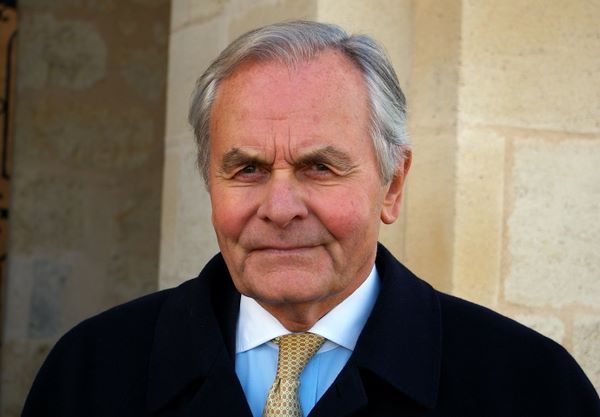
Bernard
Magrez is a self-made man who made his fortune from drinks, creating
and selling a range of drinks brands in France through his company,
William Pitters. But now he’s involved in quite a different, more
upmarket side of the business: for the last 20 years he’s been
acquiring prestigious vineyards, first of all in Bordeaux, where he
owns several chateaux, and more recently around the world. The total
count at the moment is 35 wine estates, which makes for quite a
portfolio. Although he’s recently added one more, in the Douro (no
wine has been made from this yet), he’s pretty much finished his
collecting spree, and is now looking to reinforce the Bernard Magrez
‘signature’ as a top quality brand in the world of fine wine.
[For
those who want to know more about his background and personality,
there’s a really good interview by Robert Joseph here.]
I
spent a couple of days with him in Bordeaux to visit some of his
properties, and try to get a feel for what he’s about. The purpose
of the visit was to publicise the launch of his new luxury wine
tourism venture. Tourism is something that Bordeaux has actually
been quite bad at in the past: despite the fact that it’s the
world’s largest fine wine region. Although it’s possible to
visit most of the leading properties, tourism isn’t actively
encouraged on the whole, and Bordeaux remains fairly inaccessible.
Magrez agrees that Bordeaux isn’t friendly enough towards
visitors. ‘Oenotourism is important’, says Magrez. ‘Bordeaux
is now just beginning, but slowly. One of the problems for Bordeaux
is that they haven’t developed this wine tourism before’.
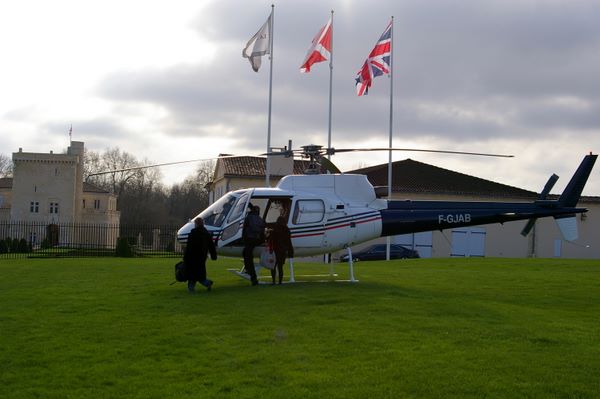
To
get a taste for what the Magrez brand of luxury wine tourism might
involve, we travelled in style, flying out from London City airport
on his private jet, and then transferring to helicopter to fly from
Bordeaux airport over the Médoc, to the first stop, Château
La
Tour Carnet, a 120 hectare estate with 68 hectares under vine.
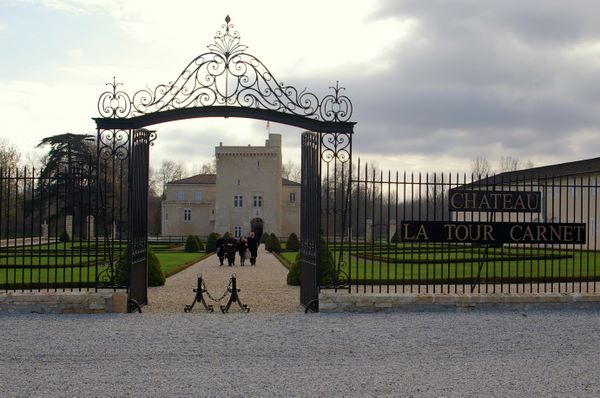
Since
taking over this fourth-growth estate, Magrez has totally renovated
the vineyards, cellar and ancient Château,
which now look stunning. As
with all his properties, winemaking is under the watchful eye of
consultant winemaker Michel Rolland, who Magrez has been working
with for 20 years. The cellar has some 2400 barrels, which is enough
to cater for two vintages at once. This means that the wines don’t
have to be out of barrel by the next vintage. New oak percentage is
60–80, and depends on the capacity of the wine. ‘We don’t want
to make wood infusions’, says Magrez.
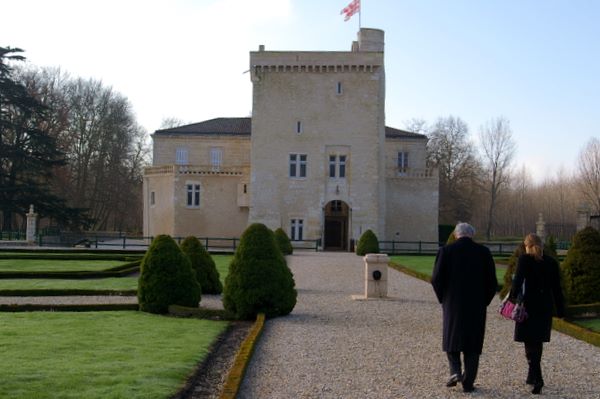
I’ve
seen a lot of cellars, and immediately Magrez’ cellars stand out
because they are spotless, and the barrels all look brand new –
great care has been taken not to spill any wine on them. Each of
Magrez’ properties conducts trials with a range of barrel makers,
with a view to improving quality, because oak quality is so
important to the final wine. Magrez has been working with Radoux to
develop even better barrels: for example, he uses special barrels
called ‘X blend’, which is a top selection of very fine grained
wood. Radox made just 20 of these barrels, and they cost double
(1200 Euros) the price of the classic barrels.
He
explained that the previous day he did a tasting comparing the 2007
vintage wine in barrels made by five different manufacturers with
this kind of top selection of wood. The goal is to improve the
quality of the whole blend. ‘Starting at around 5% of that type of
barrel you are improving the quality of the blend’, explains
Magrez. ‘Lots of small additions of detail make the difference to
quality in the end’.
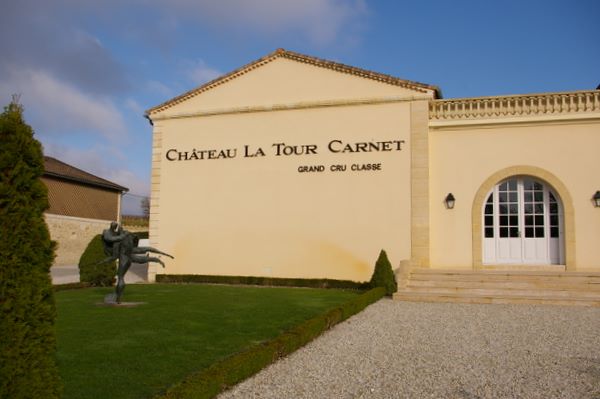
At
La Tour Carnet, selection is one of the keys to quality. Triage is
first made in the vineyard, and then there are 30 metres of sorting
tables, with 26–30 people sorting berries and taking stems out.
The aim is to have less than 2% of stems in the vats. At Château
Pape
Clement, the first and most prestigious of Magrez’ properties,
hand destemming is employed. ‘This has been done for a long time
and makes a big difference’, says Magrez. ‘We get much more
silky tannins’.
‘When
you hand destem the grapes you respect the berry’, he continues.
‘It just has a small hole at the location of the stem. Classic
destemmers rip the skin’. This hand destemming is expensive,
though, adding 2 Euros to the price of a bottle, but it is
indicative of the single-minded pursuit of quality that Magrez is
after. As well as being used for Pape Clement, hand destemming is
also employed for certain top cuvées from other properties.
He
thinks that even small gains in quality matter. ‘The quality has
risen a lot in other countries, which is providing new competition
for Bordeaux. If we don’t even try to improve it, it will be
difficult for high quality Bordeaux wine. We have vineyards across
the world and we know the improvements going on: we have contact
with the best wineries. In the whole world of wine the quality at
the top end is changing. In Bordeaux, Chateaux that don’t try to
improve themselves every year will be in trouble. The quality
overall is now so high that basic Bordeaux wine finds it difficult
to compete.’
‘One
of the reasons I work with Michel Rolland is that he is a world
winemaker’, explains Magrez. ‘In Napa he is now in charge of 9
of the top 10 properties. It is interesting to work with a man who
knows the improvement of the competitors.’
A short video
of the visit to La Tour Carnet
Anne
Lenaour is the enologist responsible for Château La Tour Carnet;
she’s been working with Magrez since 2002, and has been at La Tour
Carnet since 2002. She explained to role of Michel Rolland.
‘Rolland gives us guidelines. As well as visiting himself, he has
a team of three who also visit. A consultant is very important for a
Grand Cru. It is necessary to have a personal bond between the two
people [the consultant and the in-house enologist] so they can work
as a unit.’
Rolland
started working with Magrez in the 1990s, and now Magrez is his
biggest customer. Lenaour describes him as ‘the king of the
blend’, and as a ‘genius’. For example, Rolland and Magrez
recently did the blending for Fombrauge 2007 and Rolland remembered
the exact assemblage of the 2006 vintage. But Rolland has a
controversial image in the wine world, as a winemaker who is
manipulative (using techniques such as microoxygenation and lots of
new oak), such that his wines all tend to taste similar in an
‘international’ style. Lenaour disagrees. ‘This image is 100%
due to Mondovino [Jonathan
Nossiter’s film on the effect of globalization on the wine
industry], which was completely partisan’, she says. ‘Since
I’ve been working with him I have never heard him advise us to use
microoxygenation. That is a caricature of the man. It is also a
caricature that Rolland likes wood infusions in his wines.’
‘At
the beginning of the harvest when he tastes the grapes he knows what
maceration temperature to use, what pigeage and so on: he is very
skilled. He is probably one of the few enologists selling his
expertise and not selling any product. Most of the wines here are
made with natural fermentations.’ I asked her whether he was
expensive. ‘In Bordeaux, some advisors charge more than
Rolland’, she replied.
Magrez
is unusual among Bordeaux producers in that he has back labels, and
these include his picture. ‘In a shop or restaurant the wine lover
is facing 15–20 different Château
and doesn’t know the name or quality of the Château. In Bordeaux
there are 12000 properties making wine. For the wine lover it is
difficult to choose.’ He adds that, ‘here the producer is a man,
and the man is Bernard Magrez. People like to know the name of the
owner: it’s very important now.’ His decision to use photos on
the back label was taken after market research in Belgium, Germany
and the UK. As to breaking with convention, Magrez emphasizes that,
‘The wine lover is my boss, not my competitors!’
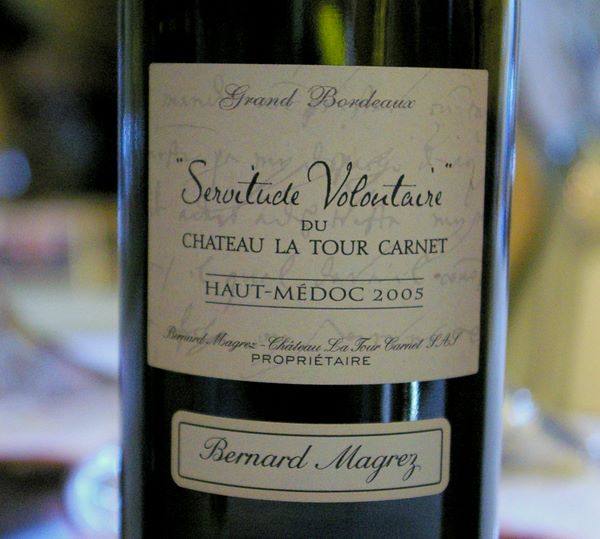
Château
La Tour Carnet Blanc 2007
From 1.2
hectares that Magrez planted, with a view to making a top quality
white. 35% Sauvignon Blanc, 31% Sauvignon Gris, 34% Semillon ;
spends 9 months in French oak. Richly fruited nose with some spicy,
sweet oak. The palate is dense and rich with powerful, rich fruit. Quite
exotic, with nicely integrated oak. 89/100
Château
La Tour Carnet Blanc 2006
Lovely
aromatics : fresh, lemony, pithy, slightly oily, grapefruity.
The palate is fresh and lemony with lovely fruit and some spicy
structure, with well integrated oak. Dense and savoury. 90/100
Château La Tour Carnet 2005
Dense and youthful, but with smooth, supple structure. Nice
dark cherry and blackberry character. Bright with a seamless
structure; currently a little closed but with great potential.
91/100
Château
La Tour Carnet 2003
Sweet,
dark, lush and spicy with nice structure. Smooth, ripe, sweet
blackcurrant and blackberry fruit with firm, minerally, spicy
tannins. Starting
to show some evolution, with some elegance. 92/100
Servitude
Voloutaire du Château La Tour Carnet 2005
This is a
special cuvee : it’s 100% Merlot and it’s hand destemmed. Rich,
smooth, spicy chocolatey nose. The
palate is concentrated and intense with ripe, smooth blackberry and
blackcurrant fruit. Very smooth and concentrated, with lushness but
also some fine-grained structure. Modern and sophisticated. 93/100
Then
we tried some wines from the previous regime, which employed machine
harvesting and higher yields. The actual yields were 60 hl/hectare,
but the vineyard was pruned for higher yields than this. It was a
vicious circle: because the price was low, more wine had to be made,
which lowered quality and kept the price low.
Now
Magrez’ team harvests each block just at the right time, taking
real risks. ‘When Michel Rolland arrived he asked us to delay
harvest, waiting and harvesting as late as we could when the seed is
almost like toast’, says Magrez. ‘Yields are much lower doing
this but the quality is better. We have lost 20 hl/hectare. ‘
Château
La Tour Carnet 1996
Earthy,
leafy aromatics. The
palate has earthy, spicy notes with some evolution evident. Open and
evolving nicely but also a bit of greenness and rusticity showing. A
savoury, mid-weight style. 87/100
Château
La Tour Carnet 1970
Aromatic and quite evolved but still alive. Nicely mineralic with
some herby, leafy notes. Quite elegant with some spice and earth
notes. It’s a really delicious midweight Claret drinking well now.
Very digestible. 89/100
Also
in this series:
Wines
tasted 11/08
Find these wines with wine-searcher.com
Back
to top
|

